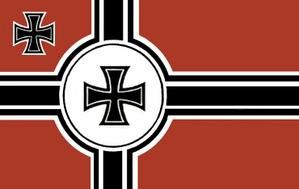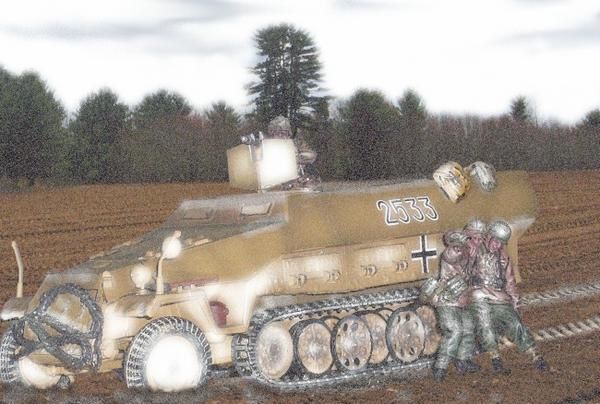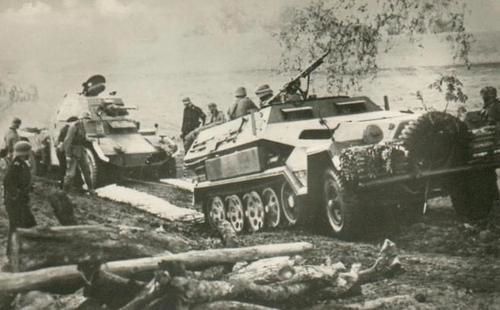



LAST STAND IN THE BLIZZARD
Officer Killed , 2 nd machine Gun lost .
one Wounded , Engine out .
And arround lot of bolshevik bastards !!!
"no lucky day"
| ........................... | German Sd. Kfz. 251/1 Ausf D | |
The Sonderkraftfahrzeug 251 (SdKfz 251) half-track was an armored fighting vehicle designed and first built by Nazi Germany's Hanomag company during World War II. They were produced throughout the war.
The early production models of this vehicle were issued to the 1st Panzer Division in 1939. There were four main models (A - D), with many variants. The initial idea was for a vehicle that could be used to transport a squad of infantry to the battlefield protected from enemy small arms fire, and with some protection from artillery fire. The open top meant that the crew was still vulnerable, especially to high explosive rounds and shell fragments.
The first two models were produced in small numbers. The C variant had a larger production run, but was a quite complex vehicle to build, involving many angled plates that gave reasonable protection from small arms fire. The D version utilized a much simpler design, and can be easily recognised by its single piece sloping rear (with flat doors).
Although designed for cross country work, it had some limitations as the front wheels were not powered.
The standard personnel carrier version was equipped with a 7.92 mm MG34 or MG42 machine gun mounted at the front of the open compartment, above and behind the driver. A second machine gun was usually mounted at the rear on an anti-aircraft mount.
These vehicles were meant to enable panzergrenadiers to accompany panzers and provide infantry support as required. In practice, there were never enough of them to go around, and many panzergrenadier units had to make do with trucks for transport. Only a very few favored divisions like Panzer Lehr received enough to fully equip their infantry units.
Variants were produced for specialized purposes, including with anti-aircraft guns, light howitzers , anti tank guns and mortars or even large unguided artillery rockets as well as a version with an infra-red search light used to spot potential targets for associated Panther tanks equipped with infrared detectors.
There were 23 official variants, and sundry unofficial variants. Each variant is identified by a suffix to the model number. There was however some overlap in the variant numbers.
- Sdkfz 251/1 - Schützenpanzerwagen. Standard personnel carrier.
- 251/1-I - As above, but with intercom facilities
- 251/1-II - Rocket launcher (called "Stuka zu Fuß" (Walking Stuka) or Wurfrahmen 40) equipped with six side mounted frames for launching 280 mm or 320 mm Wurfkoerper rockets.
- SdKfz 251/1 - Falke Infrared detection equipment, to be used in combination with SdKfz 251/20 Uhu. Mostly Ausf. D variants.
-
- Sdkfz 251/2 - Schützenpanzerwagen (Granatwerfer). 81 mm Mortar carrier
- Sdkfz 251/3 - Funkpanzerwagen. Communications vehicle, fitted with extra radio equipment for command use.
- 251/3 I FuG8 and FuG5 Radios
- 251/3 II FuG8 and FuG5 Radios
- 251/3 III FuG7 and FuG1 Radios
- 251/3 IV FuG11 and FuG12 Radios (with 9 m telescopic mast); Command vehicle variant (Kommandowagen)
- 251/3 V FuG11 Radio
-
- Sdkfz 251/4 - Schützenpanzerwagen für Munition und Zubehör des leIG18. Gun-towing tractor, initially for use with the 7.5 cm leichtes Infanteriegeschütz 18. Later used with the 50 mm Pak 38, 75 mm PaK 40 and 105 mm Light Field Howitzer.
- Sdkfz 251/5 - Schützenpanzerwagen für Pionierzug. Assault Engineer vehicle with inflatable boats, assault bridges. Command Vehicle for Pioneer platoons (Pionierzug).
- Sdkfz 251/6 - Kommandopanzerwagen. Command version equipped with map boards, cipher and encoding machines.
- Sdkfz 251/7-I - Pionierpanzerwagen. Another assault engineer vehicle with fittings to carry assault bridge ramps on the sides.
- 251/7-II - As above but with different radio.
-
- Sdkfz 251/8-I - Krankenpanzerwagen. Armoured ambulance.
- 251/8-II - As above but with different radio.
-
- Sdkfz 251/9 - Schützenpanzerwagen (7.5cm KwK37). Equipped with a 75 mm L/24 low velocity gun, nicknamed "Stummel" ("stump").
- Sdkfz 251/10 - Schützenpanzerwagen (3.7cm PaK). Equipped with a 37 mm Pak 36 anti-tank gun mount.Platoon commander's variant.
- Sdkfz 251/11 - Fernsprechpanzerwagen. Telephone line layer.
- Sdkfz 251/12 - Messtrupp und Geratpanzerwagen. Survey and instrument carrier for artillery units.
- Sdkfz 251/13 - Schallaufnahmepanzerwagen. Sound recording carrier for artillery units.
- Sdkfz 251/14 - Schallaufnahmepanzerwagen. Sound recording carrier for artillery units.
- Sdkfz 251/15 - Lichtauswertepanzerwagen. Flash spotting carrier for artillery units.
- Sdkfz 251/16 - Flammpanzerwagen. Fitted with two flame projectors and initially a rear mounted flamethrower, detachable but still connected to the vehicle, to be operated by dismounted infantry. This was in addition to the standard MG34 machine gun and mount.
- Sdkfz 251/17 - Schützenpanzerwagen (2cm FlaK38). Anti-aircraft use with either a 20 mm Flak 30 or Flak 38. Also a variant called "Schwebenlafette", rare- but used.
- Sdkfz 251/18-I - Beobachtungspanzerwagen. Artillery observation vehicle.
- 251/18-Ia - Differences unknown, likely different radio fit.
- 251/18-II - Armored observation vehicle.
- 251/18-IIa - Different radio.
-
- Sdkfz 251/19 - Fernsprechbetriebspanzerwagen. Telephone exchange vehicle.
- Sdkfz 251/20 - Schützenpanzerwagen (Infrarotscheinwerfer) Uhu Mounted an Infrared searchlight for night fighting.
- Sdkfz 251/21 - Schützenpanzerwagen mit Fla MG Drilling. Equipped with a triple-mount (in the style of a "drilling" hunting gun) of MG151 autocannon; early version being MG151/15mm cannon, later being MG151/20mm Luftwaffe cannon.
- Sdkfz 251/22 - 7.5cm PaK40 L/46 auf Mittlerem Schützenpanzerwagen. Fitted with a 75 mm PaK 40 anti-tank gun.
- Sdkfz 251/23 - 2cm Hängelafette 38 auf Mittlerem Schützenpanzerwagen. Recon version, rare- same turret as a 234/1 or a 222.
- OT-810 - Czechoslovakian produced version, made by Praga and Tatra. This version had an air cooled diesel engine, and an armored roof over the troop compartment. The vehicle was not liked by those who used it and was nicknamed "Hitler's revenge".







| Model: | Ausf A/B/C | Ausf D |
| Weight: | 7810kg | 8000kg |
| Crew: | 2 men | 2 men |
| Engine: | Maybach HL42TUKRM / 6-cylinder / 100hp | |
| Speed: | Road: 53km/h | Road: 53km/h |
| Range: | Road: 300km | Road: 300km |
| Fuel Capacity: | 160 litres | 160 litres |
| Lenght: | 5.80m | 5.98m |
| Width: | 2.10m | 2.10m |
| Height: | 1.75m | 1.75m |
| Armament: | depending on the variant | |
| Ammo: | depending on the variant | |
| Armor: | 6-14.5mm | 6-15mm |

UNIT HISTORY
As a fighting unit Großdeutschland was formed in 1939. The core of this four battalion infantry regiment came from the "Wachtregiment Berlin", a guard unit used for ceremonial purposes. The rest of the regiment came from volunteers from all areas of Germany. Thus the name Großdeutschland was used meaning "Greater Germany". The unit's first designation was "Infanterie-Regiment Großdeutschland".
At the outbreak of war with Poland the regiment was still in the midst of reorganization. Infanterie-Regiment Großdeutschland was to stay home and continue the reorganization during the Polish campaign. On 6 September 1939 it was heard that the unit was to be air-landed into Poland. This operation was cancelled due to the advance of Soviet troops into eastern Poland which made the operation unnecessary. In August 1940 the black cuff title Großdeutschland was issued to the unit and they were now a motorized formation. Although Infanterie-Regiment Großdeutschland was ready, they did not participate in the immediate invasion of France. However the unit did see some action during the campaign while fighting under the leadership of Heinz Guderian's 19th Armeekorp. Later they were attached to Kleist's command.
Großdeutschland took part in the invasion of Yugoslavia in April 1941 and then by 22 June, 1941 they headed into Russia during operation Barbarossa. In this campaign they were part of the 2nd Panzerarmee. Distinguishing itself in combat, Großdeutschland was one of the few German units to reach the out skirts of Moscow. Following the harsh winter battles from Tula to Orel, Großdeutschland served as an excellent fighting unit while suffering heavy casualties. As a result the unit under went several reorganizations. By April 1942 Armored units were added for better support. The unit was then reformed as "Infanterie-Division (mot) Großdeutschland". As a much larger unit Großdeutschland fought several major engagements ending the year west of Moscow.
On 23 June, 1943 Großdeutschland was designated "Panzer Grenadier Division Großdeutschland". By this time Großdeutschland was truly a reinforced Panzerarmee with reconnaissance consisting of Pioneer (engineer) Battalions that were fully armored. During 1943 Großdeutschland fought at Kharkov, Belgogrod and Kursk during operation Citadel. Later the unit fought in operations north of Karachev in the Orel area. In September 1943, Russian attacks forced Großdeutschland and other units south across the Dneiper river. These bitterly fought battles sent Großdeutschland to France for refitting.
In 1944 Großdeutschland fought at Targul Frumos, Poland, Lithuania, and Memel just to name a few places. In November 1944 Großdeutschland was reformed as "Panzer Korps Großdeutschland". Fighting in retreating battles Großdeutschland gained the nickname "Die Feuerwehr" (fire brigade). Suffering heavy casualties Großdeutschland fought until May 1945. Großdeutschland repeatedly faced an enemy with far superior forces while inflicting powerful blows to them. Großdeutschland held their own against enemy superiority in the field. As a World War II combat unit, their legacy left 50,000 dead including 1,500 officers killed in combat. The unit was awarded more Knights Crosses than any other formation in the German Military. Why? As General der Panzertruppe Hasso von Manteuffel once wrote: "Our honor is the fulfillment of our duty!"


MG-34
Maschinengewehr-34 (Machine gun, model of 1934), or MG-34, is known as a main infantry support weapon of the Wehrmacht (Hitlers' German Army) through first half of the World War 2, and main vehicle (tank) machine gun of the same during the whole war. MG-34 also is nototious for being the first ever true Universal machine gun, that could be used as a light machine gun from bipod, as a sustained fire, medium machine gun on tripod, as a tank or AA gun.
MG-34 was designed in the early 1930s by the team lead by Louis Stange at Rheinmetall, leading German arms manufacturer at that time. Final design, adopted for service in 1934, incorporated numerous features from experimental prototypes built by Rheinmetall, Mauser-werke, and others. As was requested by German army, it was a truly universal machine gun, capable of different roles. It was put into production circa 1935, and remained an official MG of the Wehrmacht until 1942, when it was oficially replaced my more reliable and cheap MG-42. But, despite this, MG-34 continued to serve untill the end of WW2, mostly as a tank gun, because it was better suited for this role than the MG-42.
MG-34 is a recoil-operated, selective fire weapon. It uses short recoiling barrel with muzzle recoil booster which also serves as a flash hider. Barrel locking is achieved by the rotating bolt head, with interrupted threads locking lugs, that lock into the barrel extension. Bolt head has a set of rollers, located just behind the lugs. These rollers are used to rotate bolt heads to lock and unlock, when riding inside the curved grooves, cut on the inner walls of the receiver. Rollers also act as a bolt accelerator, when bolt unlocks, due to interoperation with the barrel extension. Tubular receiver is linked to the tubular barrel sleeve by the swinging stud, set at the right side of the receiver, so receiver can be turned up and to the right relatively tho the barrel sleeve, thus exposing the barrel rear end. When receiver is opened, barrel can be simply withdrawn from its sleeve to the back, but when barrel is hot, this requires some sort of the heat protection, so MG-34 operator had to use asbestos glove which was a standard acessory to the gun. MG-34 usually was issued with belt feed, which was operated by the stud on the top of the bolt body. Belt feed could be easily set up to take the belt from the left or from the right side of the gun. With special replacement feed cover, a double-drum, saddle-type 75 rounds magazines can be used. MG-34 was a selective fire weapon, with mode of fire being controlled by dual trigger. A pull on the upper part of the trigger produced single shots, while a pull on the lower part produced full auto bursts.
Being an universal MG, MG-34 could be used in different configurations. As a light MG, it was used from light, folding bipods, which could be set up either under the muzzle or under the guns' center of gravity, allowing for better stability or better field of fire, respectively. In this mode MG-34 was usually fed from 50-rounds truncated-cone belt boxes, made of tin. Belt boxes were cillped to the receiver and allowed the gun to be carried loaded withouth dangers of belt being jammed.
In sustained fire role, MG-34 was mounted on the special tripod of very complicated and expensive design, called Lafette-34. This tripod allowed for direct or indirect fire missions, and was equipped with recoil dampers, special fire control unit and an optical scope mount. With the use of the special adapter, this tripod also can be used for antiaircraft role. For dedicated air-defence missions a special, lightweight AA tripod was also available.
As a tank gun, MG-34 was equipped with heavier barrel and armoured barrel jacket withouth the vent holes.
In general, MG-34 was an outstanding weapon, with wery fine finish and made to tight tolerances, but this become also its biggest drawback - being too expensive and too slow to manufacture, MG-34 was less than suitable for mass wartime production. It also was somewhat sensitive to dirt and fouling, a standard atrribute of the western front battles. But the most major advantage of the MG-34 was its versatility, and it set the trend for numerous latter
Caliber: 7.92x57mm Mauser
(also known as 7.9mm Mauser or 8mm Mauser)
Weigth: 10.5 kg on bipod, empty
Length: 1219 mm
Length of barrel: 627 mm
Feeding: belt, 50 or 250 rounds; double drum magazines, 75 rounds.
Rate of fire: 900 rounds/min
Muzzle velocity: 755 m/s (may vary depending on type of ammunition used)





















/idata%2F0396584%2FKOREA%2F71910_korea_MIA1_800.JPG)
/idata%2F0396584%2FU.S.ARMY-POST-WW2%2Fphot4901a.jpg)
/idata%2F0396584%2FDRAWINGS-UNIFORMS-WW2%2F30-451-09b-2.jpg)
/idata%2F0396584%2FP-40%2F44FS000.jpg)
/idata%2F0396584%2FGERMAN-U-BOAT%2FBundesarchiv_Bild_101II-MW-1031-28-_Lorient-_U-31.jpg)
/idata%2F0396584%2FSOVIET-ARMY-WW2%2F1.jpg)





